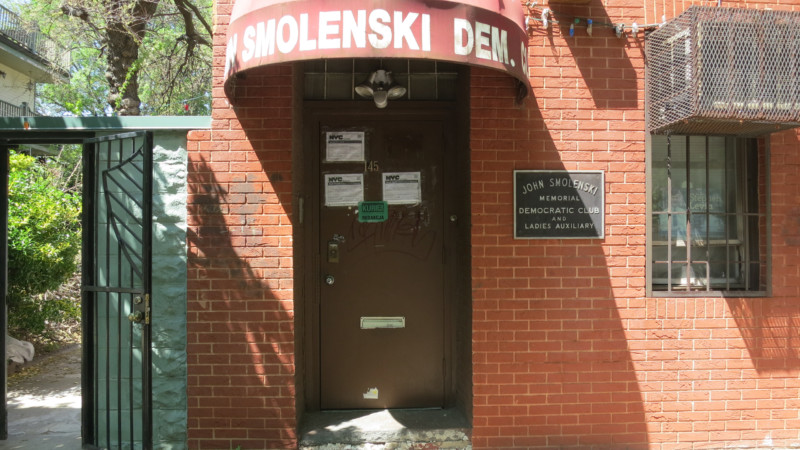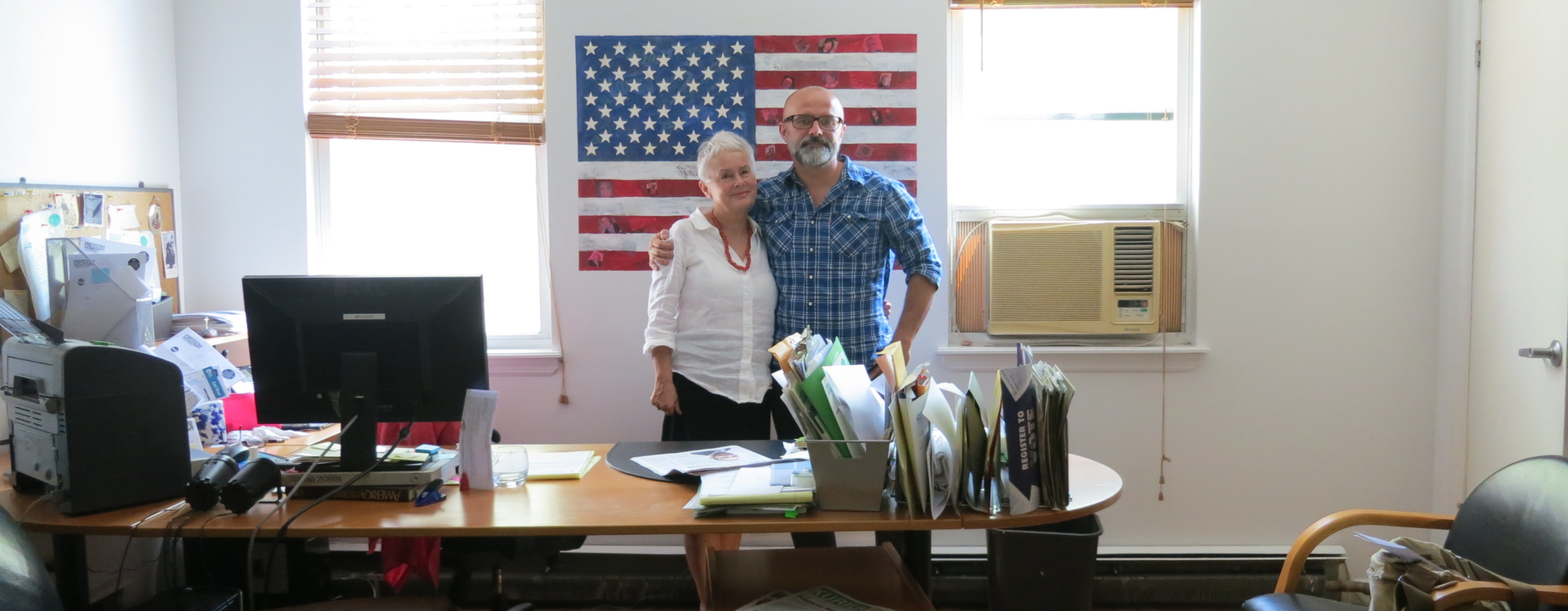When Zofia Doktorowicz-Kłopotowska moved from Warsaw to New York in 1987, Brooklyn’s Greenpoint neighborhood was saturated with local Polish newspapers. She immediately joined the ranks of Kurier Plus, which had only begun publishing that year, and then bought the paper in 1994. Today she and her son run the weekly, which is one of just two weekly Polish outlets left in New York, and the only Polish-language weekly in Greenpoint—and it is thriving.
Kurier Plus’s modest office is located on the second floor of a brick building on Greenpoint’s Java Street. A piece of green paper bearing Kurier’s logo, taped among the work permits on the front door, is one of the only signs of Kurier’s residency here. Inside, there are two desks—one for Doktorowicz-Kłopotowska, 71, the other for a woman who helps field phone calls. “The writers send in their articles, and the computer person, who’s usually here two days a week, does the paper remotely from his home, and then he comes in and touches it up,” says Rafe Kłopotowski, 42, Doktorowicz-Kłopotowska’s son. About his role at the paper, Kłopotowski says, “I don’t really have a formal position, I do everything. I help run whatever she may need.”
ICYMI: The decimation of local news in New York City
A visit to the neighborhood newsstand on Greenpoint and Manhattan avenues reveals a ream of Polish papers and magazines among the English-language publications. What is not immediately obvious is that most of these publications are foreign papers published in Poland and made available in Brooklyn to cater to the expat community. According to members of the Polish media interviewed for this piece, the local press is struggling, a winnowing version of its former self. While the success of Greenpoint-based Polish papers was safeguarded for many years by the neighborhood’s status as a community hub, both demographic and digital changes have eroded that protective wall.

The Kurier Press office on Java Street. Photo by Hannah Frishberg.
In 2010, Greenpoint’s English-language paper, The Polish-American World, folded after 51 years of serving the community, explaining to readers that its finances were an “economic fiasco.” In 2011, then-daily paper Nowy Dziennik, considered the leading Polish-American news source, moved its newsroom from West 38th Street in Manhattan to Garfield, New Jersey. In January 2016, it became a weekly, with publishers citing loss of advertising revenue and shrinking sales for the reduced publishing schedule. According to an undated list of newspapers kept by the New York Press Association, Nowy Dziennik and Kurier Plus are the only weekly Polish-language newspapers still serving NYC.
The Polonia here in New York City are leaning towards publications that deal exclusively with the events happening around Polish communities in the States—events and news that one cannot simply find on the internet, or in English newspapers.
Aleksandra Słabisz, who has been with Nowy Dziennik for 12 years, says the internet’s effect on the Polish and American presses is comparable. “We are all on the same wagon,” says Słabisz. Nowy Dziennik‘s audience does not read mainstream US papers due to the language barrier—a characteristic that historically strengthened the paper’s position, but may undercut it in the age of online news. With fewer Poles immigrating to the US, some longtime residents now learning English, and newcomers immigrating with prior English fluency, Słabisz doesn’t expect the circulation of Nowy Dziennik to rise in the foreseeable future.
Czeslaw Karkowski, who has written columns for Kurier Plus for close to a decade, says there is no difference in the struggles faced by Polish versus American media: The problems, he says, “are identical, plus additional difficult competition with the Polish paper magazines imported from Poland. So we may say that Polish local magazines have an extra-tough existence.”
“Generally speaking, the Polonia here in New York City are leaning towards publications that deal exclusively with the events happening around Polish communities in the States—events and news that one cannot simply find on the internet, or in English newspapers,” says Agnieszka Granatowska, editor in chief of Echo Polonijne, a free quarterly paper released by the Polish Slavic Center, headquartered in Greenpoint. Previously, Granatowska worked for Super Express, a Polish tabloid published in Warsaw with many writers and a large distribution in the United States.
In the past three years, Granatowska says, Echo Polonijne has more than doubled its publication, increasing from 2,000 copies a quarter in 2015 to a current circulation of 5,000 a quarter. “It came to our attention that there are more Poles scattered in the states neighboring New York who were interested in our paper,” she says. Though Greenpoint does not feel as Polish as it once did, says Granatowska, “that does not affect the readership.”
Recently, Kurier Plus also expanded into New Jersey, with a starting circulation of 500 issues. (This is in addition to its 7,000 weekly print circulation along the East Coast.) The paper, which also claims a growing digital audience, now covers more local news in all of its distribution areas, including Pennsylvania, Massachusetts, and Connecticut—a precautionary measure against the challenges of the news landscape.
When I press Kłopotowski to explain how, in today’s bleak media environment, Kurier is increasing its print run, he credits a strong sense of community, Polish pride, and longtime loyalty from readers. “We just have a following,” he says. “Polish people want to support their publications.”
The expansion reflects not only Kurier’s success, but also Greenpoint’s stagnant Polish population: While many of the Polish-owned businesses continue to prosper along the neighborhood’s commercial stretches, it’s no secret that the forces of gentrification and the call of the old country have rendered Brooklyn’s Little Poland less and less Polish. “There is no influx,” Kłopotowski says of the local Polish population in Greenpoint. “It’s just fewer and fewer Poles.” While Greenpoint remains a commercial core, Ridgewood, Maspeth, and out-of-state towns have become the primary residences for much of the Polish community, who have sold property in Greenpoint or been pushed out by rising rents.
As with the Polish population in Greenpoint, the local Polish press is shrinking, Doktorowicz-Kłopotowska says. There are a number of papers that periodically pop up and serve the community then disappear after a few years, such as Bialy Orzel, a Boston-based publication which recently began distributing in New York and New Jersey after a hiatus.
My column tells stories about my life here. Poles around the world want to hear about Greenpoint.
Kurier Plus, however, is unrivaled in its status as Greenpoint’s local Polish paper. In its more than 30 years serving the area, its word-of-mouth reputation has solidified the paper as a beloved news source—and made Doktorowicz-Kłopotowska a community matriarch.
“I don’t know if you caught on, but she’s kind of this one-woman force,” Kłopotowski says. “She’s everybody’s mom. She has people coming [to the office] being like, I want to rent out this space but I can’t pay you anything, and she’s like, That’s OK, not a problem.”
Over the years, Doktorowicz-Kłopotowska has made Kurier’s office space available for numerous gallery shows, concerts, performances, and gatherings. Her generosity has garnered her and her paper much loyalty in their immigrant community. “She says that she has people who have been writing the same column for 20 years,” Kłopotowski tells me in English, translating for his mother. “Some people just grow into that and they never want to leave Kurier.”
Columnists, Kłopotowski emphasizes, are the paper’s backbone. One Kurier columnist, Weronika Kwiatkowska, has written her column for 12 years. “The Double Life of Veronique” explores the author’s “deep sense of duality as an immigrant,” Kłopotowski says. “My column tells stories about my life here.” Most of her readers find her column online. “Poles around the world want to hear about Greenpoint,” says Kwiatkowska.
As the Polish residential community stagnates, slowly but surely vacating buildings for newcomers, the Polish press morphs and moves. Kurier Plus and Echo Polonijne have thrived despite these challenges, in part because of their hyperlocal appeal. Once-stalwart publications like Nowy Dziennik are weakened, but alive.
The Polish press, in large part because of language barriers, exists in a world apart from the vast majority of American media consumers. Yet with publisher powerhouses cum community leaders such as Doktorowicz-Kłopotowska, the digital powers that be remain at bay—at least for now.
ICYMI: Why I’m devoting a year to helping black newspapers survive
Hannah Frishberg is a fourth-generation Brooklynite and freelance reporter. She was previously the Editor in Chief of Brokelyn. Her work has appeared in the New York Post, CityLab, Gothamist, and elsewhere. Follow her on Twitter @hfrishberg.

